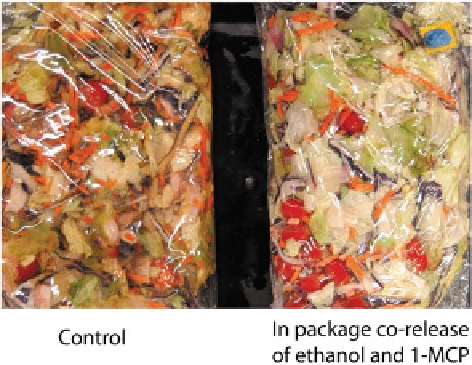Agriculture Reference
In-Depth Information
Fig. 13.3
Potential for a
co-release technology sachet
to control compatibility prob-
lems when ethylene produc-
ing tomatoes are packaged
in salad mixes containing
ethylene sensitive vegetables
such as lettuce and carrot
shreds. Packages of salad mix
were obtained directly from
a fresh-cut processor and
stored at 5 °C for 4 weeks.
A full description of the
technology is provided by Lu
et al. (
2008
)
consumers with an on package incorporated color patch that will change color as
the fruit softens and develops sweetness for eating quality (http://www.ripesense.
com/). Technologies providing similar cues to retailers and consumers will help to
reduce waste by indicating which fruit are ready for immediate consumption and
which require time to ripen. Such technologies would be useful for fruits such as ki-
wifruit, avocados or melons. Similar technologies could be developed for packaged
fresh-cut product indicating remaining shelf life for the product, thus encouraging
timely product cycling on the retail shelves and consumption for the consumer.
Is it Possible to Reduce Losses and/or Enhance Retention
of Nutritional Value to the Consumer?
It is possible to both reduce losses and enhance retention of nutritional value for
the consumer? Nutritional value is linked to fruit and vegetable retaining appear-
ance and texture expectations of the consumers. Generally when produce is of good
visual and tactile quality the nutritional value is high (Gil et al.
2006
). Therefore,
the challenge is to minimize the rate of perceptible deterioration in quality for the
product and the goal of nutrition retention should be achieved. Two factors probably
have most effect on both quality and nutrition retention; (1) temperature, and (2)
water loss. Nutritional components such as vitamin C may decline when significant
water loss occurs (Lee and Kader
2000
). Temperature has a two-fold effect, it will
govern the rate of biochemical processes leading to over-ripening and also warmer
handling temperatures also lead to greater water loss. Modified atmospheres have
also been shown however to improve vitamin C retention (Lee and Kader
2000
).
Losses of labile vitamins can be resolved through development of better packaging
systems and through better education of the consumer regarding home refrigeration
management.

